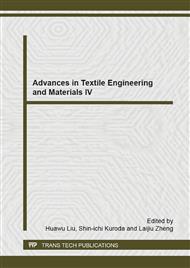[1]
Babich H, Devanas M, Stotzky G. The mediation of mutagenicity and clastogenicity of heavy metals by physicochemical factors. Environmental research 1985; 37: 253-86.
DOI: 10.1016/0013-9351(85)90107-0
Google Scholar
[2]
Mudhoo A, Garg VK, Wang S. Removal of heavy metals by biosorption. Environmental Chemistry Letters 2012; 10: 109-17.
DOI: 10.1007/s10311-011-0342-2
Google Scholar
[3]
Gök Ö, Özcan A, Erdem B, Özcan AS. Prediction of the kinetics, equilibrium and thermodynamic parameters of adsorption of copper (II) ions onto 8-hydroxy quinoline immobilized bentonite. Colloids and Surfaces A: Physicochemical and Engineering Aspects 2008; 317: 174-85.
DOI: 10.1016/j.colsurfa.2007.10.009
Google Scholar
[4]
Klemm D, Heublein B, Fink HP, Bohn A. Cellulose: fascinating biopolymer and sustainable raw material. Angewandte Chemie International Edition 2005; 44: 3358-93.
DOI: 10.1002/anie.200460587
Google Scholar
[5]
O'Connell DW, Birkinshaw C, O'Dwyer TF. Heavy metal adsorbents prepared from the modification of cellulose: A review. Bioresource Technology 2008; 99: 6709-24.
DOI: 10.1016/j.biortech.2008.01.036
Google Scholar
[6]
Gurgel LVA, Júnior OK, Gil RPdF, Gil LF. Adsorption of Cu (II), Cd (II), and Pb (II) from aqueous single metal solutions by cellulose and mercerized cellulose chemically modified with succinic anhydride. Bioresource Technology 2008; 99: 3077-83.
DOI: 10.1016/j.biortech.2007.05.072
Google Scholar
[7]
Oshima T, Kondo K, Ohto K, Inoue K, Baba Y. Preparation of phosphorylated bacterial cellulose as an adsorbent for metal ions. Reactive and Functional Polymers 2008; 68: 376-83.
DOI: 10.1016/j.reactfunctpolym.2007.07.046
Google Scholar
[8]
Ding Z, Yu R, Hu X, Chen Y, Zhang Y. Graft copolymerization of epichlorohydrin and ethylenediamine onto cellulose derived from agricultural by-products for adsorption of Pb (II) in aqueous solution. Cellulose 2014; 21: 1459-69.
DOI: 10.1007/s10570-014-0246-y
Google Scholar
[9]
Isobe N, Chen X, Kim U-J, Kimura S, Wada M, Saito T, et al. TEMPO-oxidized cellulose hydrogel as a high-capacity and reusable heavy metal ion adsorbent. Journal of hazardous materials 2013; 260: 195-201.
DOI: 10.1016/j.jhazmat.2013.05.024
Google Scholar
[10]
Raji C, Anirudhan T. Batch Cr (VI) removal by polyacrylamide-grafted sawdust: kinetics and thermodynamics. Water Research 1998; 32: 3772-80.
DOI: 10.1016/s0043-1354(98)00150-x
Google Scholar
[11]
Hashem A. Amidoximated Sunflower Stalks (ASFS) as a New Adsorbent for Removal of Cu (II) from Aqueous Solution. Polymer-Plastics Technology and Engineering 2006; 45: 35-42.
DOI: 10.1080/03602550500371620
Google Scholar
[12]
Shibi IG, Anirudhan TS. Polymer‐grafted banana (Musa paradisiaca) stalk as an adsorbent for the removal of lead (II) and cadmium (II) ions from aqueous solutions: kinetic and equilibrium studies. Journal of Chemical Technology and Biotechnology 2006; 81: 433-44.
DOI: 10.1002/jctb.1423
Google Scholar
[13]
Singha AS, Guleria A. Chemical modification of cellulosic biopolymer and its use in removal of heavy metal ions from wastewater. Int J Biol Macromol 2014; 67: 409-17.
DOI: 10.1016/j.ijbiomac.2014.03.046
Google Scholar
[14]
Güçlü G, Gürdağ G, Özgümüş S. Competitive removal of heavy metal ions by cellulose graft copolymers. Journal of Applied Polymer Science 2003; 90: 2034-9.
DOI: 10.1002/app.12728
Google Scholar
[15]
Kubota H, Suzuki S. Comparative examinations of reactivity of grafted celluloses prepared by uv-and ceric salt-initiated graftings. European Polymer Journal 1995; 31: 701-4.
DOI: 10.1016/0014-3057(95)00037-2
Google Scholar
[16]
Zhang Y, Xu L, Zhao L, Peng J, Li C, Li J, et al. Radiation synthesis and Cr (VI) removal of cellulose microsphere adsorbent. Carbohydrate Polymers 2012; 88: 931-8.
DOI: 10.1016/j.carbpol.2012.01.040
Google Scholar
[17]
Pillai C, Paul W, Sharma CP. Chitin and chitosan polymers: Chemistry, solubility and fiber formation. Progress in Polymer Science 2009; 34: 641-78.
DOI: 10.1016/j.progpolymsci.2009.04.001
Google Scholar
[18]
Chen A-H, Liu S-C, Chen C-Y, Chen C-Y. Comparative adsorption of Cu (II), Zn (II), and Pb (II) ions in aqueous solution on the crosslinked chitosan with epichlorohydrin. Journal of hazardous materials 2008; 154: 184-91.
DOI: 10.1016/j.jhazmat.2007.10.009
Google Scholar


